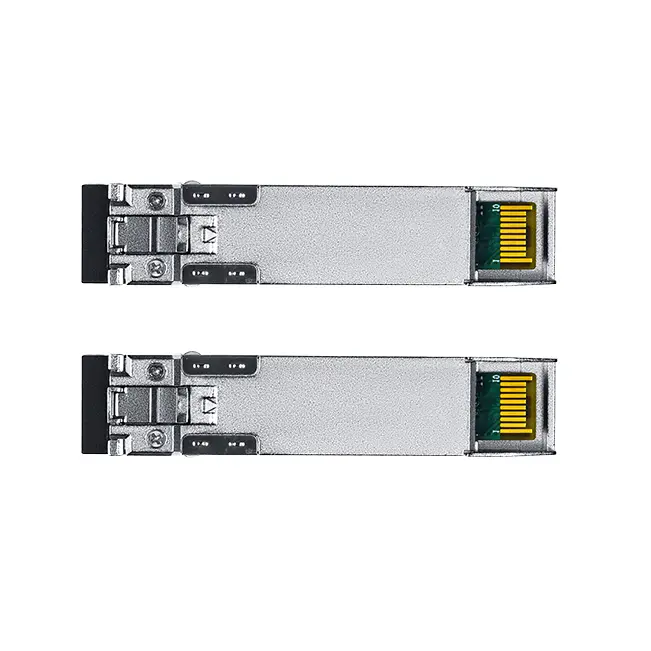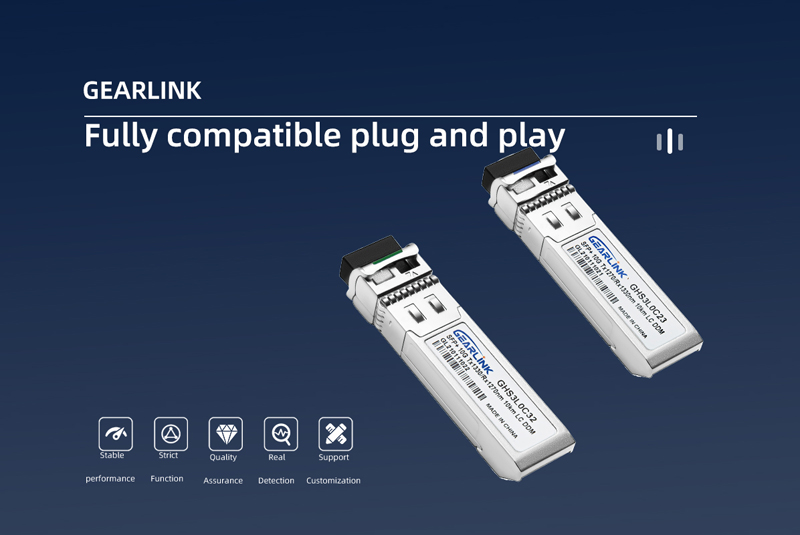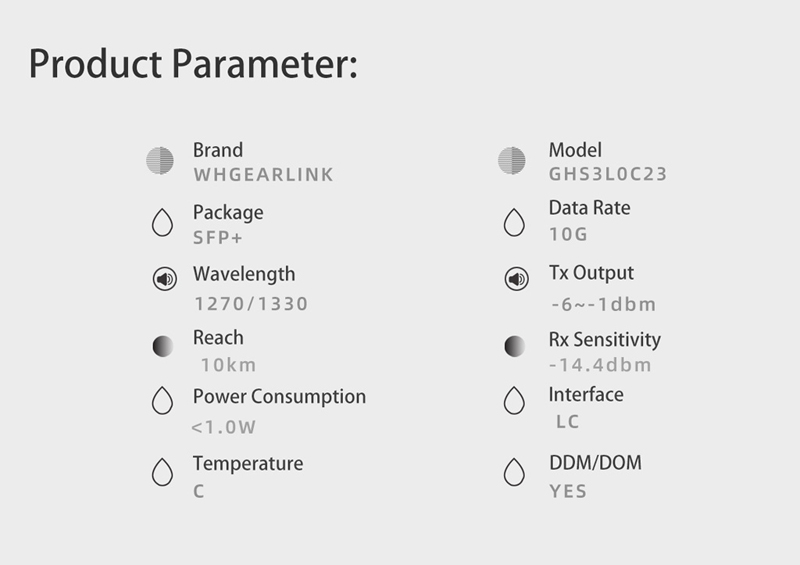
The SFP-10G-BX series single mode transceiver is a small form factor plug module for duplex optical data communications such as 10GBASE-LR/LW defined by IEEE 802.3ae. It is with the SFP+ 20-pin connector to allow hot plug capability.
The SFP-10G-BX module is designed for single-mode fiber and operates at a nominal wavelength of 1270nm; the SFP-10G-BX module is designed for single-mode fiber and operates at a nominal wavelength of 1330nm. The sfp 10g transmitter section uses a multiple quantum well DFB, which is class 1 laser compliant according to International Safety Standard IEC-60825.
The gbic sfp 10g receiver section uses an integrated InGaAs detector preamplifier (IDP) mounted in an optical header and a limiting post-amplifier IC.
| SFP-10G-BX10U-I | 10G BIDI SFP+ TX:1270nm/RX:1330nm 10km |
| SFP-10G-BX20U-I |
| EX-SFP-10GE-BX10-U | 10G BiDi SFP+ Tx:1270nm/Rx:1330nm 10km |
| EX-SFP-10GE-BX20-U | 10G BiDi SFP+ Tx:1270nm/Rx:1330nm 20km |
| GP-SFP-10GBX-U-10 | 10GBASE-BX10-U SFP+ Tx:1270nm/Rx:1330nm 10km |
| 10GB-BX10-U | 10GBASE-BX10-U TX:1270nm/RX:1330nm SFP+ |
| 02310QBJ | 10GBASE-BX10-U 1270nm-TX/1330nm-RX SFP+ |
Parameter | Symbol | Min | Typ. | Max | Unit |
Bit Rate | BR | 10.3125 | 11.3168 | Gb/s etc | |
Max.Supported Link Length | Max | 10 | km |
Parameter | Symbol | Min | Typ. | Max | Unit | Ref. |
Storage Temperature | TS | -40 | 85 | ºC | ||
Power Voltage | VCC | -0.5 | 3.6 | V |


The 10 Gigabit single-fiber optical transceiver has only one optical fiber interface. An optical fiber transmits and receives optical signals in two directions at the same time. The dual-fiber optical transceiver has two optical fiber interfaces. Connect two optical fibers. In an optical fiber, only signals in the same direction are transmitted. Single-fiber optical transceiver s are generally used in pairs
BIDI optical transceiver s must be used in pairs. It has only one interface connected to an optical fiber. This interface needs to send and receive light at the same time. At this time, another BIDI optical transceiver is required to receive the light it sends and emit the light it needs. of light. The advantage of BIDI optical transceiver s is to save fiber resources.
First of all, the most obvious difference is the appearance: the single-fiber optical transceiver has only one interface, which is connected to one optical fiber. The dual-fiber optical transceiver has two interfaces to connect two optical fibers. The single-fiber optical transceiver has two working wavelengths, one for receiving and one for sending. The dual-fiber optical transceiver has only one working wavelength. Differences in speed: Generally speaking, single-fiber transceiver s have a wide range of applications at 100M, 1000M and 10M rates. There are few in 40G and 100G high-speed transmission. The dual-fiber optical transceiver is a transmission scheme that everyone often chooses.
Compared with traditional dual-fiber transceiver s, BIDI transceiver s can better save fiber resources. The reduction of optical fibers saves the cost of cabling infrastructure and facilitates the management of optical fibers.
Some cameras nowadays integrate a BIDI optical transceiver , and the BIDI optical transceiver s need to be used in pairs. Then the opposite end needs to be connected by another optical transceiver . The advantage of this solution is that it reduces the cost of wiring and optical fiber transceivers, and reduces the number of relay devices in the middle.